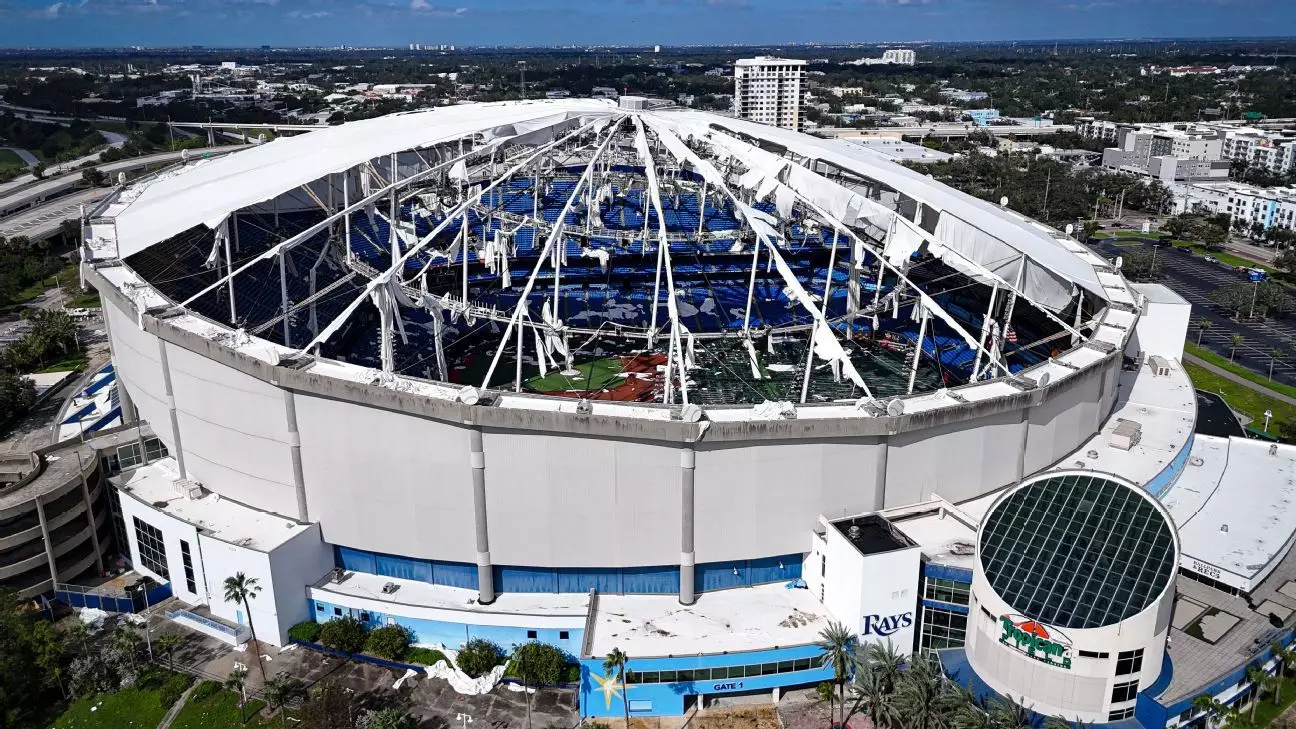In the wake of Hurricane Milton, Tropicana Field, home of the Tampa Bay Rays, has endured a significant test of resilience. Although the storm wreaked havoc on its fabric roof—resulting in the failure of 18 out of 24 fabric panels—the underlying structure of the domed stadium has been assessed as fundamentally sound. A 412-page report issued by the city of St. Petersburg underscores that while the roof requires extensive repairs estimated at $55.7 million, the stadium’s primary structural integrity remains intact.
The report, conducted by Hennessy Construction Services, reassures that the existing framework can support a new tension membrane fabric roof. However, while the structural elements survive, the impact of severe weather has introduced complications, such as interior damage inflicted by rainfall and the subsequent mobilization of storm-related debris throughout the venue. The discussion surrounding the stadium’s future now takes center stage as time progresses toward the impending 2026 season.
With an eye toward maintaining continuity, the Tampa Bay Rays face the immediate challenge of securing alternative accommodations for the upcoming year, as repairs will stretch well into 2026. Major League Baseball is advocating for a solution that retains the team’s location within proximity to its fanbase. Several local spring training sites are being floated as potential temporary homes, including facilities used by the New York Yankees, Philadelphia Phillies, and Toronto Blue Jays, among others.
This transition poses its own set of challenges for the Rays. Finding a suitable venue that not only meets MLB standards but also resonates with fan loyalty and local support will be crucial. The realities of fan engagement and maintaining a competitive spirit during the upheaval cannot be understated, as the franchise navigates both practical logistics and emotional connections to their community.
The path ahead is strewn with financial complexities. Consequently, the city of St. Petersburg faces the dual burden of repairing an aging facility while preparing for the long-term vision of a new $1.3 billion ballpark, slated for completion in 2028. This future development—articulated as part of a broader $6.5 billion initiative—aims to rejuvenate the Historic Gas Plant District and pay tribute to a once-thriving Black community displaced by urban development.
However, the recent challenges posed by Hurricane Milton have redirected financial priorities. With substantial expenses expected for debris removal and infrastructure restoration following two recent hurricanes, some city officials are voicing skepticism regarding the feasibility of funding repairs to Tropicana Field. As Council member Brandi Gabbard aptly noted, finding a balance between community needs and support for the Rays is paramount.
The question of who ultimately bears the financial responsibility for the repairs is fraught with complications, including a significant insurance deductible of $22 million, leaving the city to grapple with the possibility of using taxpayer dollars. The financial aftermath presents a minefield of implications, as expenditures on the stadium compete with pressing needs throughout St. Petersburg.
While the city has earmarked $6.5 million for immediate cleanup and protective measures against further storm damage, ongoing discussions will be essential in aligning the community’s support for the Rays against the backdrop of broader resource allocation. Local sentiment regarding the team bears influence, yet the community is increasingly clamoring for transparency and accountability as the city’s financial priorities are re-evaluated.
The upcoming St. Petersburg City Council meeting on November 21 will shape the discourse surrounding the future of Tropicana Field. The decisions made in the weeks ahead will influence not only the immediate future of the Rays but also the socio-economic revitalization of the area surrounding the stadium. As discussions progress, ensuring that the experience of local fans and the health of the community remain prioritised will be instrumental in forging a path for both the present and future of the Rays in St. Petersburg.
The implications of hurricane damage at Tropicana Field extend far beyond the physical structure; they involve intricate layers of community, economics, and a vision for the future that honors past legacies while addressing contemporary challenges.


Leave a Reply